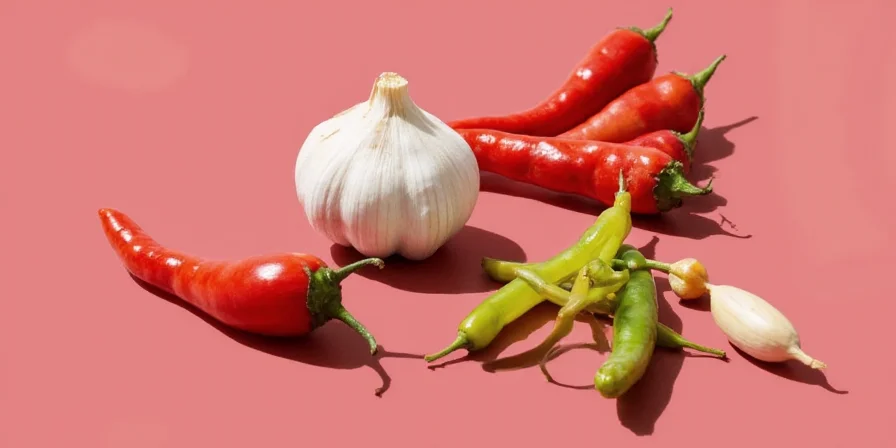Garlic, Salt, Pepper – The Dynamic Trio of Seasoning
Table of Contents
- Introduction: Why This Trio Rules the Spice Rack
- Spice Basics: Garlic, Salt & Pepper Explained
- Top 10 Practical Tips for Using Garlic, Salt & Pepper
- Common Myths and Misconceptions
- Pairing with Other Spices: Flavor Combinations That Work
- Visual Guide: Comparing Flavors and Uses
- Conclusion: Master These, and You’re Already a Seasoned Chef!
Introduction: Why This Trio Rules the Spice Rack
If there were a Mount Rushmore for kitchen staples, garlic, salt, and black pepper would definitely be on it. They might seem simple — like the basic ingredients in your spice drawer that never get the spotlight — but make no mistake: they're the backbone of flavor in kitchens around the world.

Spice Basics: Garlic, Salt & Pepper Explained
Let’s break down these three powerhouse ingredients:
- Garlic: A pungent bulb known for its strong aroma and complex flavor profile. Contains allicin, which gives it antibacterial properties.
- Salt: Not just for making things salty. Salt enhances other flavors and balances bitterness. There are many types — table salt, sea salt, kosher salt, Himalayan pink salt, etc.
- Black Pepper: Often called the “king of spices,” it contains piperine, which boosts nutrient absorption and adds depth to dishes.
| Ingredient | Flavor Profile | Best Use |
|---|---|---|
| Garlic | Pungent, savory, slightly sweet when roasted | Sautéed, roasted, raw in dressings or sauces |
| Salt | Salty, briny | Seasoning meats, balancing sweetness, curing |
| Black Pepper | Earthy, spicy, woody | Finishing dishes, ground fresh, added early in cooking |
Top 10 Practical Tips for Using Garlic, Salt & Pepper
- Toast It Up: Toast whole garlic cloves in olive oil before adding them to dishes. It mellows out the sharpness and brings out nutty notes.
- Use Freshly Ground Black Pepper: Whole peppercorns retain their essential oils better than pre-ground versions. Invest in a good grinder!
- Different Salts for Different Goals: Use coarse salt for meat rubs, fine salt for baking, and flaky salt for finishing.
- Layer Your Seasoning: Don’t throw all your garlic, salt, and pepper into the pot at once. Layer them throughout the cooking process for depth of flavor.
- Mince Smart: Crush garlic first (with the flat side of your knife) before mincing. It helps release more of those aromatic compounds.
- Avoid Bitter Burn: Garlic burns easily! If sautéing, keep the heat low and cook slowly unless you want a bitter, acrid flavor.
- Balance Is Key: Salt can overpower everything else. Taste as you go and remember — you can always add more, but you can’t take it away!
- Pepper Power: Add black pepper after cooking if you want a brighter finish, or earlier for deeper warmth.
- Infuse Your Oil: Make flavored oils by gently infusing garlic and pepper into olive or neutral oil. Perfect for drizzling over grilled veggies or bread.
- Don’t Forget Roasted Garlic: Roasting garlic turns it sweet and creamy. Smash a few cloves onto mashed potatoes or blend into hummus.

Common Myths and Misconceptions
There’s a lot of confusion floating around about these basics. Let’s clear up some of the biggest myths:
- Myth: More garlic = better flavor.
Reality: Too much garlic can turn bitter or overpower other ingredients. Balance is key. - Myth: All salts are created equal.
Reality: Each type of salt has different textures and mineral content, affecting how salty something tastes. - Myth: Black pepper isn’t necessary.
Reality: Piperine in black pepper increases the bioavailability of nutrients and enhances other spices.

Pairing with Other Spices: Flavor Combinations That Work
Garlic, salt, and pepper are great solo players, but they shine even brighter when paired with other spices. Here are some combos to try:
- Garlic + Paprika + Olive Oil: Spanish-inspired magic. Great on potatoes or seafood.
- Salt + Citrus Zest: Enhances natural sweetness and brightness. Try on grilled fish or desserts.
- Pepper + Cumin + Chili Flakes: Adds warmth and earthiness. Ideal for stews or chili.

Visual Guide: Comparing Flavors and Uses
To help you visualize how garlic, salt, and pepper interact with different foods and techniques, here’s a handy comparison chart:
| Spice | Cooking Method | Best For | Flavor Effect |
|---|---|---|---|
| Garlic | Raw | Salsas, dressings | Strong, sharp, fiery |
| Roasted | Mashed potatoes, spreads | Sweet, mellow, creamy | |
| Sautéed | Pasta sauces, stir-fries | Warm, nutty, rich | |
| Salt | Kosher Salt | Meat rubs, pickling | Coarse texture, clean taste |
| Sea Salt | Finishing, baked goods | Bold, crunchy, mineral-rich | |
| Himalayan Pink Salt | Steak, gourmet plating | Elegant look, mild salinity | |
| Black Pepper | Whole Peppercorns | Marinades, stocks | Fragrant, robust |
| Freshly Ground | Final seasoning, soups | Vibrant, spicy | |
| Pre-Ground | Baking, blends | Convenient, subtle |

Conclusion: Master These, and You’re Already a Seasoned Chef!
Garlic, salt, and black pepper may not be flashy, but they are the unsung heroes of flavor. With a little knowledge and a bit of practice, you can unlock their full potential and transform everyday meals into culinary masterpieces.
So next time you reach for that shaker of pepper or crush a clove of garlic, remember: you're wielding one-third of the most powerful flavor team in the kitchen. Respect it, use it wisely, and above all… season like a pro!












 浙公网安备
33010002000092号
浙公网安备
33010002000092号 浙B2-20120091-4
浙B2-20120091-4